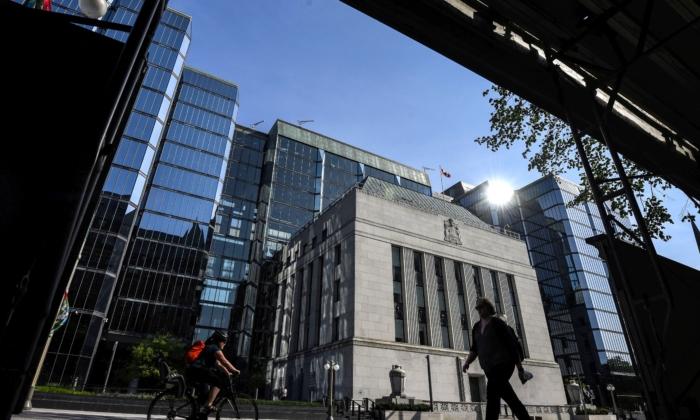The Canadian and American central banks are pulling out all the stops to support the economic recovery, with the latest move being their indications that they expect to hold interest rates near zero over the next few years. However, as the COVID-19 pandemic persists, the hoped-for sustained revival in consumer borrowing and spending is anything but certain.
In an unprecedented move on Sept. 16, the U.S. Federal Reserve said it doesn’t expect to raise its key interest rate until 2023, providing a very powerful signal that near-zero rates are here to stay for a long time.
A week earlier, the Bank of Canada had said, “The Governing Council will hold the policy interest rate at the effective lower bound [0.25 percent] until economic slack is absorbed so that the 2 percent inflation target is sustainably achieved.”
In Canada, the annual rate of inflation has been stuck at just 0.1 percent for the past two months. The 2 percent target is an international standard to keep price increases under control while promoting the economic and financial well-being of citizens.
Ever since the financial crisis, interest rates have been very low by historical standards, but there was always that element of uncertainty about when rates might go up. And they eventually did in the United States and Canada.
But now the U.S. and Canadian central banks have laid out their game plans very clearly to remove uncertainty and incentivize consumers and businesses to spend and invest—and take on risk. It’s an extreme use of one of the tools of their monetary policy—forward guidance.
Borrowing Less Appealing, Spending Impacted
Benjamin Tal, deputy chief economist at CIBC, told The Epoch Times that he doesn’t see a big pickup in consumer spending, as this really needs higher-income households to play their part. What has happened during the pandemic is that the rate of savings has gone up since incomes have been supported on the whole, but spending has fallen.
Lower-income households tend to spend that extra dollar but also have fewer dollars to spend, as lower-paying jobs like in retail and hospitality have been more impacted by the pandemic.
As for the housing market, an important contributor to consumer spending that’s been a big winner benefiting from near-zero interest rates, it’s soared from pent-up demand. However, Tal doesn’t see a return to the extended red-hot housing markets and talk of bubbles bursting from a few years back, as unemployment is still much higher than pre-COVID and the economy is still in the grips of the pandemic.
Tal notes that while mortgage debt is growing, debt from consumer loans and credit cards is diminishing.
“I suggest that the credit accumulation will not recover in a very significant way over the next six months, because the [pandemic] fear factor will be dominating again,” he said.
If consumer spending and business investment were to pick up, as policy-makers hope, this would lead to more jobs being created.
“Lower borrowing costs stimulate economic activity, which in turn boosts jobs and incomes, particularly for people with lower incomes,” said Bank of Canada governor Tiff Macklem in a Sept. 10 speech to the Canadian Chamber of Commerce in Ottawa.
Poorer people generally rent and aren’t always able to borrow and buy houses, so it’s less clear how providing ultra-cheap credit is helping this segment of the population with spending on housing, says Nipissing University emeritus professor of economics Christopher A. Sarlo.
“I think it’s going to have more effect on the middle class,” he told The Epoch Times. “Ongoing full-time work is the surest escape from poverty.”
Meanwhile, those who rely on an investment return from bonds are seeing their incomes shrivel and may be pushed into the stock market, taking on additional risk at a time in their lives when it would not typically be advisable.
“With any return on fixed income, which is basically approaching zero, more and more money is chasing risk assets, like the stock market, creating the risk. So this is not a healthy situation,” Tal said.
New Approach to Inflation
Central banks want to make sure inflation expectations—an important driver of the actual inflation rate—don’t undershoot the 2 percent target, which would complicate the recovery process, University of Waterloo economics professor Jean-Paul Lam told The Epoch Times.
Falling inflation expectations lead to people delaying purchases and businesses delaying capital spending, since they think it will be cheaper to do so in the near future. And if this goes on for some length of time, the economy could suffer.
Lam points out another problem with falling inflation expectations.
“If inflation expectations keep falling, then the cost of borrowing in real terms is increasing,” he said.
Central banks are trying to lower the cost of borrowing by keeping interest rates at near-zero levels. However, advertised rates don’t factor in inflation, so if the public is expecting inflation to fall, their effective real interest rate could actually be higher than what the advertised rates suggest. Thus the central bank would be spinning its wheels.
Central banks want to stimulate the economy and have inflation rise so that the real interest rate is falling and the cost of borrowing is effectively cheaper.
“The traditional tools of monetary policy will be extremely limited,” Lam said. “So how can you get monetary policy to be a bit more effective?”
This is where the Fed’s new inflation strategy comes in.
“The [Federal Open Market] Committee will aim to achieve inflation moderately above 2 percent for some time so that inflation averages 2 percent over time and longer-term inflation expectations remain well anchored at 2 percent,” stated the Fed on Sept. 16.
Tal expects the BoC to follow the Fed’s lead. If it doesn’t, that could push the Canadian dollar higher and hinder exports, since U.S. interest rates could stay lower for longer to boost inflation.
“I would expect the Bank of Canada to do something along this line, either formally or defacto,” he said.
Even with the Fed providing interest rate certainty in an unprecedented way, economists say, as does chair Jerome Powell, that it’s likely that more government spending will be needed even to meet its current projections for growth and inflation.
Kathy Bostjancic, chief U.S. financial economist at Oxford Economics, said in a note that it is her firm’s view that the Fed will keep rates right where they are “until mid-2024 and perhaps even longer.”





